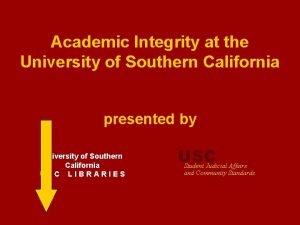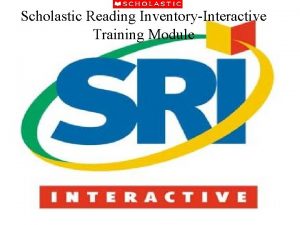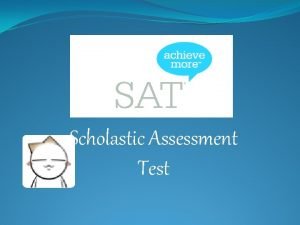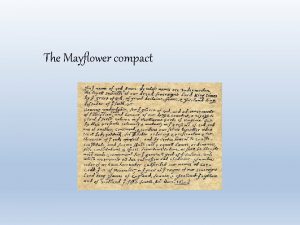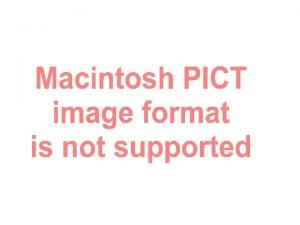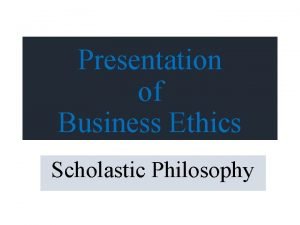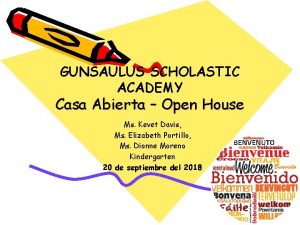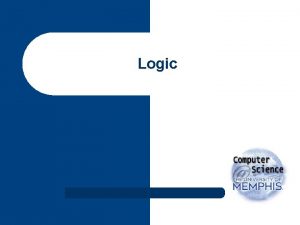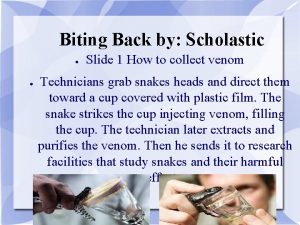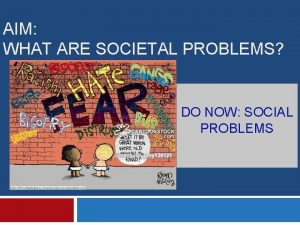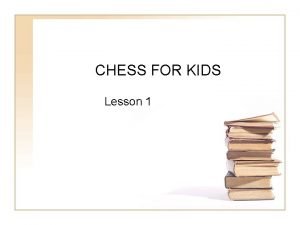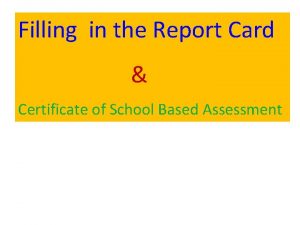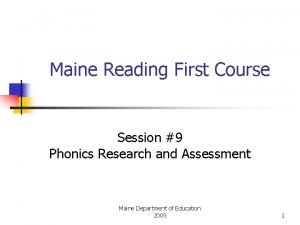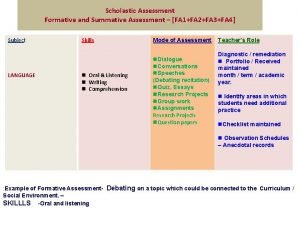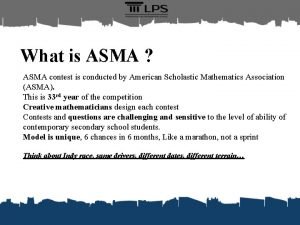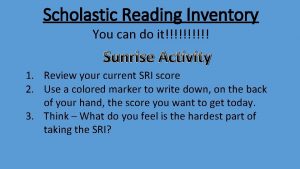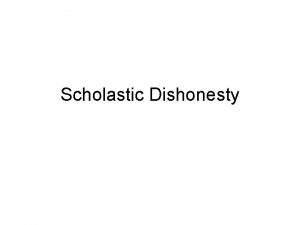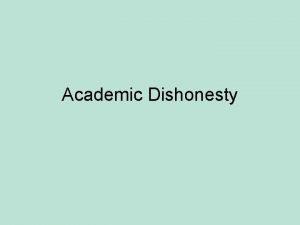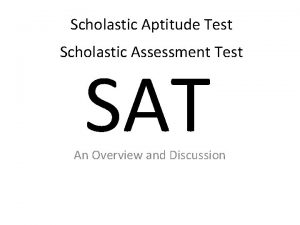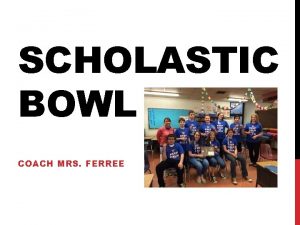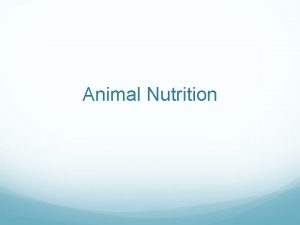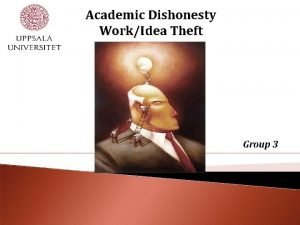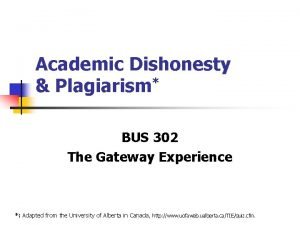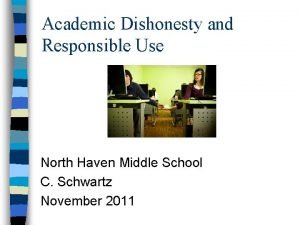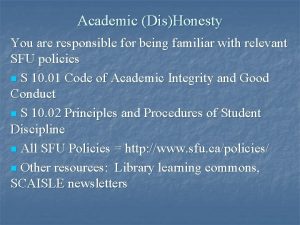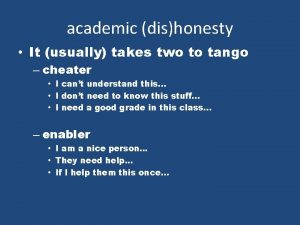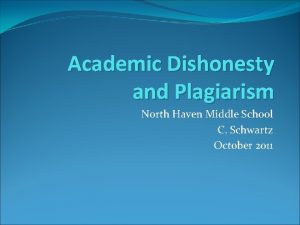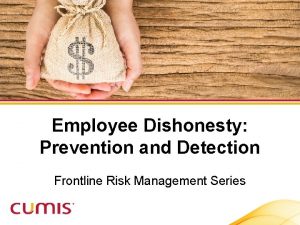Scholastic Dishonesty What is Scholastic Dishonesty Taken from





















- Slides: 21

Scholastic Dishonesty

What is Scholastic Dishonesty? Taken from The University of Texas System Regents’ Rules and Regulations. "Cheating on a test includes; i. Copying from another student’s paper; ii. Using during a test, materials not authorized by the person giving the test; iii. Failing to comply with instruction given by the person administering the test which would include, but not be limited to, time restrictions, use of blue book, and seating arrangements; iv. Possession during a test of material which are not authorized by the person giving the test, such as class notes or specifically designed “crib notes. ” The presence of textbooks constitutes a violation only if they have been specifically prohibited by the person administering the test.

What is Scholastic Dishonesty? v. Collaborating with or seeking aid or receiving assistance from another student or individual during a test or in conjunction with other assignment without authority; vi. Knowingly using, buying, selling, stealing, transporting, or soliciting in whole or part the contents of a test, test key, homework solution, or computer program; vii. Discussing the contents of an examination with another student who will take the examination or soliciting another student who has taken the test to obtain information regarding contents of the test; viii. Divulging the contents of an examination, for the purpose of preserving questions for use by another, when the instructor has designated that the examination is not to be removed from the examination room or not to be returned to or kept by the student; ix. Substituting for another student or permitting another student to substitute for one’s self to take a test, a course, or any course-related assignment;

What is Scholastic Dishonesty? x. Paying or offering money or other valuable thing to, or coercing another person to obtain an unadministered test, test key, homework solution, or computer program, or information about an unadministered test, test key, homework solution, or computer program; xi. Falsifying research data, laboratory reports, and/or other academic work offered for credit; xii. Submission of substantial portions of the same academic work for credit (including oral reports) more than once without written authorization from the instructor; and xiii. Taking, keeping, misplacing, or damaging the property of the University, or of another, if the student knows or reasonably should know that an unfair advantage would be gained by such conduct.

What is Scholastic Dishonesty? "Plagiarism" includes, but is not limited to, the appropriation of, buying, receiving as a gift, or obtaining by any means material that is attributable in whole or in part to another source, including words, ideas, illustrations, structure, computer code, other expression and media, and presenting that material as one’s own academic work being offered for credit.

What is Scholastic Dishonesty? • "Collusion" includes, but is not limited to, the unauthorized collaboration with another person in preparing academic assignments offered for credit or collaboration with another person to commit a violation of any section of the rules of scholastic dishonesty.

What is Scholastic Dishonesty? ”Falsifying academic records” includes, but is not limited to, altering or assisting in the altering of any official record of the University or the University of Texas System, and/or submitting false information or omitting requested information that is required for or related to any academic record of the University or University of Texas System. Academic records include, but are not limited to, applications for admission, the awarding of a degree, grade reports, test papers, registration materials, grade change forms, and reporting forms used by the Office of the Registrar. A former student who engages in such conduct is subject to a bar against admission, revocation of a degree, and withdrawal of a diploma.

What is Scholastic Dishonesty? ”Misrepresenting facts” to the University or an agent of the University or the University of Texas System includes, but is not limited to, providing false grades or resumes; providing false or misleading information in an effort to receive postponement or an extension on a test quiz, or other assignment for the purpose of obtaining an academic or financial benefit for oneself or another individual; or providing false or misleading information in an effort to injure another student academically or financially.

Why is Scholastic Dishonesty such a Concern? • First, it is lying. You are presenting someone else’s work as your own. The original author may have done extensive research in order to write this document. • Second, it is an insult to your fellow students. You are getting an unfair advantage over those who play by the rules. You are demeaning their accomplishment. • Third, it is stealing. You are claiming someone else’s ‘product’ as your own. (http: //www. csubak. edu/ssric/Modules/Other/plagiarism. htm) • Fourth, you are cheating yourself. Learning how to create and process your own ideas is an integral part of your academic career. Through forms of scholastic dishonesty, you are hindering that process and limiting your own academic growth.

Plagiarism: the Most Common form of Scholastic Dishonesty? Taken from: http: //www. csubak. edu/ssric/Modules/Other/plagiarism. htm It is an easy trap to fall into. When writing, your must keep good track of your sources. Staffen's review begins as follows: It has become fashionable to reject the notion of absolute objectivity on the grounds that objectivity is simply unattainable or, even if attainable, is undesirable. Plagiarism: I feel it has become fashionable to reject the notion of absolute objectivity on the grounds that objectivity is simply unattainable.

Plagiarism It has become fashionable to reject the notion of absolute objectivity on the grounds that objectivity is simply unattainable or, even if attainable, is undesirable. Plagiarism: I feel it has become stylish to reject the idea of absolute objectivity on the grounds that objectivity cannot be achieved.

Plagiarism It has become fashionable to reject the notion of absolute objectivity on the grounds that objectivity is simply unattainable or, even if attainable, is undesirable. Plagiarism: Many people today have rejected the idea that there is such a thing as absolute objectivity since they do not believe that it can be achieved.

NOT Plagiarism It has become fashionable to reject the notion of absolute objectivity on the grounds that objectivity is simply unattainable or, even if attainable, is undesirable. Proper use: Lisa Staffen (1996: 154) begins her review of Porter's book by suggesting "It has become fashionable to reject the notion of absolute objectivity on the grounds that objectivity is simply unattainable or, even if attainable, is undesirable. " Bibliography: Lisa R. Staffen, "Featured Essays, " Contemporary Sociology , March, 1996, Vol. 25, No. , 2, pp. 154 -156.

NOT Plagiarism It has become fashionable to reject the notion of absolute objectivity on the grounds that objectivity is simply unattainable or, even if attainable, is undesirable. Proper use: In her review of Porter's book, Lisa Staffen (1996: 154) says the idea of absolute objectivity is now commonly rejected as "simply unattainable or, even if attainable, [as] undesirable. " Proper use: According to Lisa Staffen (1996: 154), it has become fashionable to reject the idea of absolute objectivity altogether.

Choosing When to Give Credit Taken from: http: //owl. english. purdue. edu/handouts/research/r_plagiar. html Need to Document §When you are using or referring to somebody else’s words or ideas from a magazine, book, newspaper, song, TV program, movie, Web page, computer program, letter, advertisement, or any other medium §When you use information gained through interviewing another person §When you copy the exact words or a "unique phrase" from somewhere §When you reprint any diagrams, illustrations, charts, and pictures §When you use ideas that others have given you in conversations or over email No Need to Document §When you are writing your own experiences, your own observations, your own insights, your own thoughts, your own conclusions about a subject §When you are using "common knowledge" — folklore, common sense observations, shared information within your field of study or cultural group §When you are compiling generally accepted facts §When you are writing up your own experimental results

Making Sure You Are Safe When researching, notetaking, and interviewing Action during the writing process Appearance on the finished product §Mark everything that is someone else’s words with a big Q (for quote) or with big quotation marks §Indicate in your notes which ideas are taken from sources (S) and which are your own insights (ME) §Record all of the relevant documentation information in your notes Proofread and check with your notes (or photocopies of sources) to make sure that anything taken from your notes is acknowledged in some combination of the ways listed below: §In-text citation §Footnotes §Bibliography §Quotation marks §Indirect quotations

Making Sure You Are Safe When paraphrasing and summarizing Action during the writing process Appearance on the finished product §First, write your paraphrase and summary without looking at the original text, so you rely on your memory. §Next, check your version with the original for content, accuracy, and mistakenly borrowed phrases §Begin your summary with a statement giving credit to the source: According to Jonathan Kozol, . . . §Put any unique words or phrases that you cannot change, or do not want to change, in quotation marks: . . . "savage inequalities" exist throughout our educational system (Kozol).

Making Sure You Are Safe When quoting directly Action during the writing process Appearance on the finished product §Keep the person’s name near the quote in your notes, and in your paper §Select those direct quotes that make the most impact in your paper -- too many direct quotes may lessen your credibility and interfere with your style §Mention the person’s name either at the beginning of the quote, in the middle, or at the end §Put quotation marks around the text that you are quoting §Indicate added phrases in brackets ([ ]) and omitted text with ellipses (. . . )

Making Sure You Are Safe When quoting indirectly Action during the writing process Appearance on the finished product §Keep the person’s name near the text in your notes, and in your paper §Rewrite the key ideas using different words and sentence structures than the original text §Mention the person’s name either at the beginning of the information, or in the middle, or at that end §Double check to make sure that your words and sentence structures are different than the original text

Deciding if Something is "Common Knowledge" • Taken from: http: //owl. english. purdue. edu/handouts/research/r_plagiar. html Material is probably common knowledge if. . . • You find the same information undocumented in at least five other sources • You think it is information that your readers will already know • You think a person could easily find the information with general reference sources

Exercises for Practice Below are some situations in which writers need to decide whether or not they are running the risk of plagiarizing. In the Y/N column, indicate if you would need to document (Yes), or if it is not necessary to provide quotation marks or a citation (No). If you do need to give the source credit in some way, explain how you would handle it. If not, explain why. Situation 1. You are writing new insights about your own experiences. 2. You are using an editorial from your school's newspaper with which you disagree. 3. You use some information from a source without ever quoting it directly. 4. You have no other way of expressing the exact meaning of a text without using the original source verbatim. 5. You mention that many people in your discipline belong to a certain organization. 6. You want to begin your paper with a story that one of your classmates told about her experiences in Bosnia. 7. The quote you want to use is too long, so you leave out a couple of phrases. 8. You really like the particular phrase somebody else made up, so you use it. Y/N If yes, what do you do? If no, why?
 Usc academic integrity policy
Usc academic integrity policy Uta academic dishonesty
Uta academic dishonesty What is academic dishonesty
What is academic dishonesty Scholastic reading inventory practice test
Scholastic reading inventory practice test Collgeboard
Collgeboard Why did the mayflower compact happen
Why did the mayflower compact happen Http://teacher.scholastic.com/activities/immigration/tour/
Http://teacher.scholastic.com/activities/immigration/tour/ New york station
New york station Malala paragraph
Malala paragraph Scholastic philosophy of ethics
Scholastic philosophy of ethics Gunsaulus scholastic academy
Gunsaulus scholastic academy Scholastic logic
Scholastic logic Scholastic snake bites
Scholastic snake bites Upfront scholastic
Upfront scholastic Chess rules for kids
Chess rules for kids Co scholastic certificate
Co scholastic certificate Scholastic nonsense word test
Scholastic nonsense word test Scholastic records example
Scholastic records example American scholastic mathematics association past papers
American scholastic mathematics association past papers Reading inventory scores
Reading inventory scores Scholastic academy for academic excellence
Scholastic academy for academic excellence Sn.1.scholastic
Sn.1.scholastic
